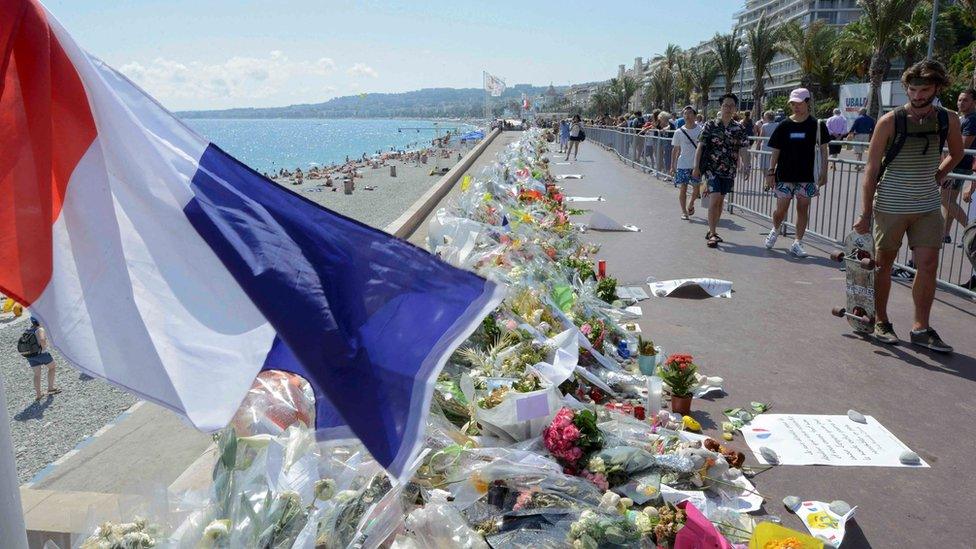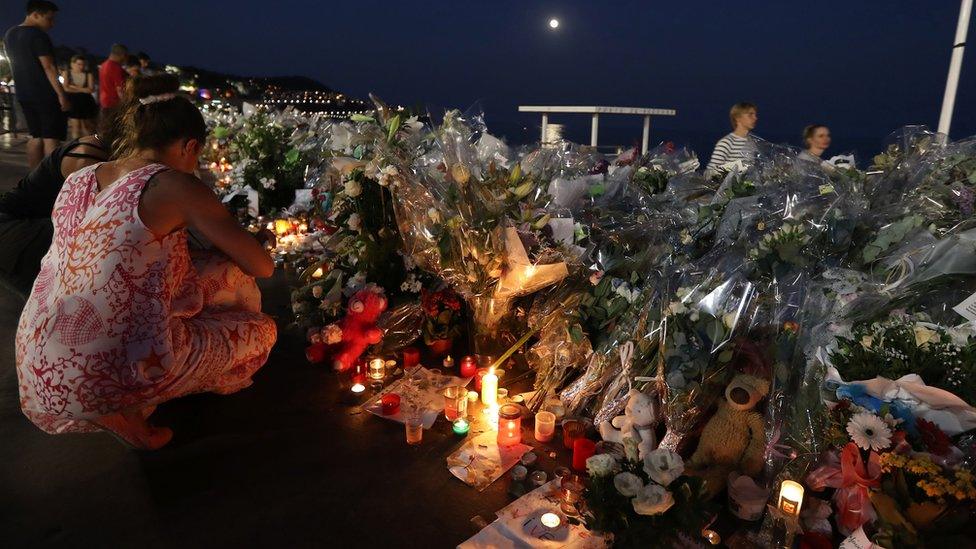Nice lorry attack: Five suspected accomplices charged
- Published

Flowers have been left along the Promenade des Anglais in Nice
Five suspects have appeared in court in France charged with terror offences in relation to the Nice lorry attack in which 84 people were killed.
The four men and one woman, aged between 22 and 40, are accused of helping prepare the terror attack, claimed by so-called Islamic State.
One suspect returned to the scene of the attack the next day to film the aftermath, prosecutors say.
France is sending artillery to Iraq next month for the fight against IS.
The move was announced by President Francois Hollande on Friday. France has been conducting air strikes against the group and providing military training but is not committing ground troops.
The driver of the lorry, Mohamed Lahouaiej-Bouhlel, drove into a crowd celebrating the Bastille Day holiday on 14 July.
He received logistical support for the attack from the five suspects, prosecutor Francois Molins said, and had planned the attack for several months.
Three of the suspects, identified as Franco-Tunisians Ramzi A and Mohamed Oualid G, and a Tunisian named Chokri C, were charged as accomplices in "murder by a group with terror links".
An Albanian man named as Artan and a women who is a French-Albanian dual national, identified as Enkeldja, are suspected of providing Lahouaiej-Bouhlel with a pistol and were charged with "breaking the law on weapons in relation to a terrorist group".
All five will be held in custody, Mr Molins said.
Like Lahouaiej-Bouhlel, none of those detained were known to French intelligence prior to the attack, although Ramzi A had previous convictions for drugs and petty crime, Mr Molins said.
He said information from Lahouaiej-Bouhlel's phone showed searches and photos that indicated he had been studying an attack since 2015.
IS said Lahouaiej-Bouhlel was one of its "soldiers" - but the lorry driver had not been on any French police watch list.
As the Bastille Day crowd enjoyed festivities on Nice's Promenade des Anglais, Lahouaiej-Bouhlel careered his large white lorry towards them.

Makeshift memorials have been set up along the Promenade des Anglais in Nice
Two police officers opened fire when he mounted the kerb, but he simply accelerated and then zigzagged for up to 2km (1.25 miles), leaving a trail of carnage.
Police finally managed to bring the lorry to a halt, raking the driver's cabin with gunfire and killing Lahouaiej-Bouhlel.
More than 300 people were wounded in the attack.
France has extended its state of emergency until the end of January 2017. It gives the police extra powers to carry out searches and to place people under house arrest.
Too few police?
The government has also launched an inquiry into police actions in Nice on 14 July, amid claims that there were too few police to block a lorry that killed 84 people.
Just one local police car was on duty at the point where the lorry careered onto the pedestrian promenade, the daily Liberation reported.
The local police had neither enough time nor firepower to stop the lorry, it said.
That version of events was disputed by Interior Minister Bernard Cazeneuve.
He said Liberation was referring to a separate, local police roadblock that was diverting traffic. The main roadblock at the start of the promenade was manned by six national police officers, who were "the first to confront the deadly lorry", he said, adding that two police cars of the national police had been stationed there.